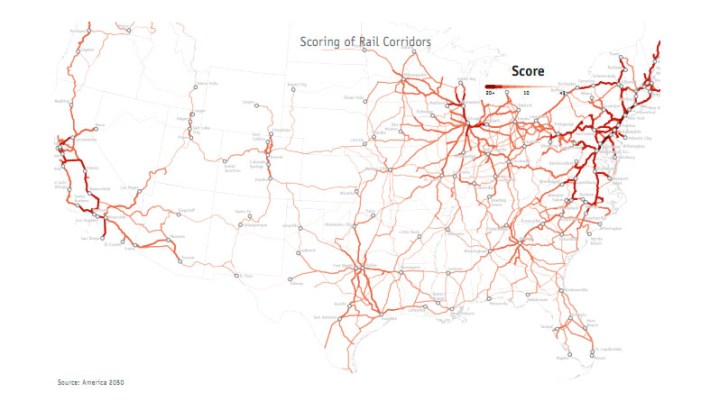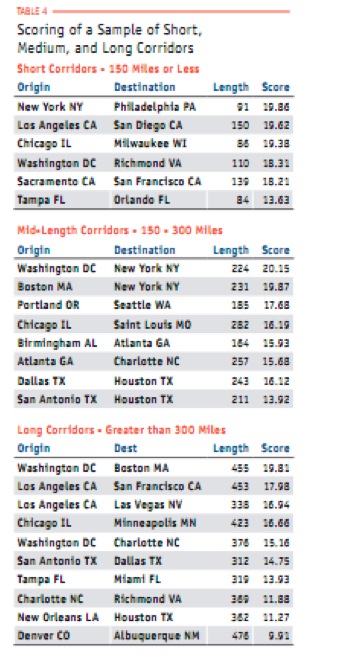
Perhaps it goes without saying, but when you’re advocating for something, it's not enough to make it happen – it has to succeed. If you get what you want and it’s a miserable failure, you’ve made matters far worse for your cause.
That’s the quandary some high speed rail advocates find themselves in now. Some ardent rail supporters have recently found themselves in the awkward position of arguing against the proposed Florida line, for example, fearing that such a line is doomed to low ridership.
But which corridors would be destined for success? America 2050, a nonprofit that advocates for infrastructure investment to prepare for future population growth, has provided a new tool for advocates who want to make sure they’re pushing projects with the best potential to succeed. Its new report, "High Speed Rail in America" [PDF], could help guide the process of expanding rail in the future.
America 2050, as an organization, focuses on what it calls “megaregions” – defined as “large networks of metropolitan areas” – where it expects the most population growth to take place. This research focuses on those megaregions as the places with the greatest likelihood for high levels of ridership.
Here’s what the report authors found:
• High-speed rail works in very specific conditions, primarily in corridors of approximately 100–600 miles in length where it can connect major employment centers and population hubs. Such corridors exist primarily in the nation’s 11 megaregions, where over 70 percent of the nation’s population and productivity is concentrated.
• Some of the best opportunities for attracting ridership are in corridors of less than 150 miles, such as New York-Philadelphia, Los Angeles-San Diego, and Chicago-Milwaukee.
• Very large cities are potentially powerful generators of rail ridership. The presence of a very large city on a corridor with medium-size and smaller cities has greater impact than connecting medium cities of the same size for generating ridership.
• Composition of the workforce within a metro region may have significant implications on regional intercity travel. People who work in knowledge industries, such as those in the financial sector, tend to travel more for business than those in industrial sectors.
See the table to the right for America 2050’s predictions for the best chances for high speed rail success. Not surprisingly, short, medium, and long corridors in the country’s primary megaregions fare the best. And that Florida line? It ranks well, but not at the top.
The report authors say Florida’s “population, employment, and transit characteristics” don’t make it a clear choice for immediate investment in high speed rail capacity, and they point to other factors that put the state at the front of the line for federal funds: “project readiness and public ownership of the right-of-way between Tampa and Orlando.” Note that those aren’t the factors America 2050 identifies as key for project success.
The report goes into detail about each region of the country to identify factors that could lead to success or failure as a high speed rail corridor. Check to see how yours rates. [PDF]
The Northeast – from Boston to Washington, or even all the way to Charlotte – is the best case scenario. It wins on every front “from population, density, employment, share of knowledge workers, to transit connectivity.”
Transit is a major factor for the success of inter-city rail. In order to persuade people to leave their cars at home, they need to know that they can move around easily without a car once they get to their destination. And density, in turn, is a major factor for the success of transit. The report argues for central business districts, accessible by transit, as essential for the whole model to work. Los Angeles' 30/10 initiative, the report argues, makes it a better candidate for high speed rail. Transit also helps improve Portland-Seattle-Vancouver's chances for success as a high speed rail corridor, though it doesn't have the density that makes it a sure bet.
High speed rail has the capacity to take passengers away from short-jump air travel. According to the report, “The three major airports in the New York metropolitan area have an average on time arrival performance of 68 percent, the worst of any major metropolitan area,” with other major offenders causing delays throughout the Northeast region.
Meanwhile, the report authors put their money on California as the country's single best bet to divert short haul air travel to rail. "Rail trip times of less than three hours between Los Angeles and the Bay Area are likely to capture the vast majority of the point-to-point air travel between the two regions."
With traffic jams par for the course on the region’s highways and airways, why couldn’t high speed rail take over as the clear choice for efficient, reliable, on-time travel in the nation’s busiest corridors?






